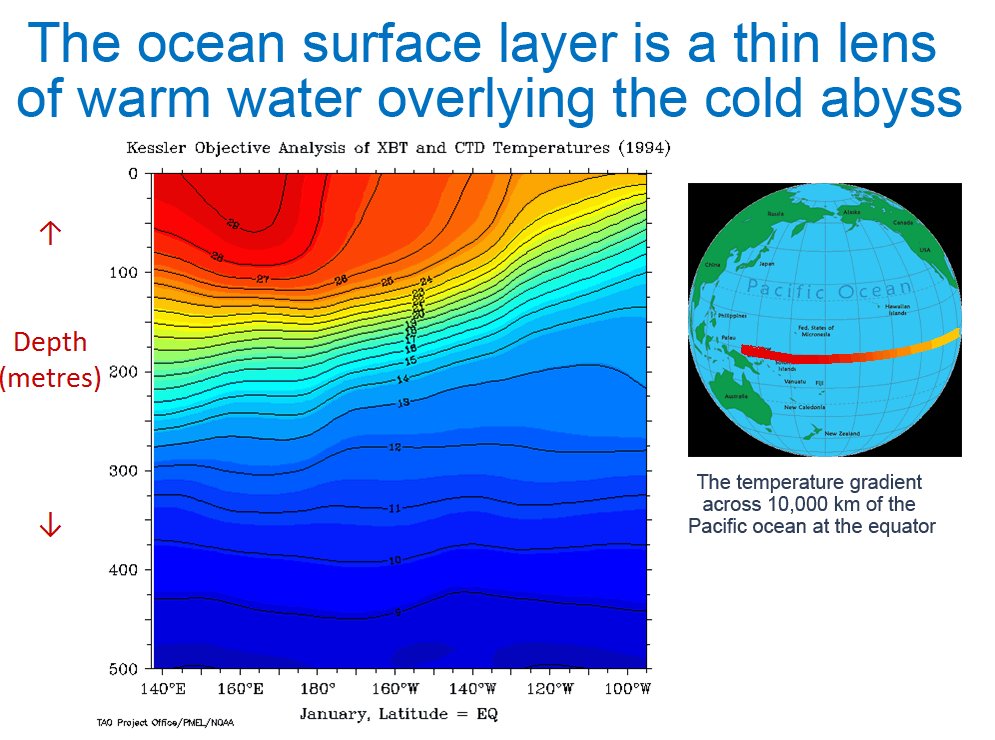We can hear the angst and confusion — Another “nasty La Nina?”, “Something weird is going on”, “They (La Ninas) don’t know when to leave”. Oh no!
These are not the words we’d expect to hear from experts who can 97% predict the climate a century from now. The bad news for the modelers is that the climate on Earth seems to be controlled more by the Pacific Oscillation than anything else and they have no idea what drives that pattern, so they can’t predict it more than a few months ahead, and sometimes not even then. And if they can’t predict the Pacific — they can’t predict anything. The hottest of hot years are El Nino, and the coldest years are La Nina and the greatest modelers the world-has-ever-known still get their barbecue summers wrong. The droughts, the floods and the bushfires follow the swinging surface water of the worlds largest ocean. Whenever they happen, the models say “climate change” but the models never tell us which will hit us this time next year.
So here we are with hints that there might be another La Nina, a third in a row, and Oh-the-disappointment! The modelers thought there would be more El Ninos — oh Queen of Global Heating. Instead, in the last 40 years, La Nina’s seem to be getting more common. The models were wrong.
And this failure is of the Grande Mal kind.
Holy Smoke — the Pacific matters
As William Kinninmonth so incisively pointed out — the oceans are 4 kilometers deep and most of the water is only a few degrees above freezing, even under the tropical Pacific. There is a world of cold down there, and the layer of warm water on top is but a thin skin. If that thin skin of warm water rests undisturbed, the air can heat above. But all it takes is a change in dominant currents, or tradewinds, or some new deep sea magma vent to stir up the ocean and the top layers mix. The gargantuan deep blue blob of 3 kilometer thick salty cold water promptly rises up and sucks the warmth out of the sky.
The insipid weak vapor above is no match for the vast energy sink below.

….
CBS NEWS: Weather’s unwanted guest: Nasty La Nina keeps popping up
Something weird is up with La Nina, the natural but potent weather event linked to more drought and wildfires in the western United States and more Atlantic hurricanes. It’s becoming the nation’s unwanted weather guest and meteorologists said the West’s megadrought won’t go away until La Nina does.
The current double-dip La Nina set a record for strength last month and is forecast to likely be around for a rare but not quite unprecedented third straight winter. And it’s not just this one. Scientists are noticing that in the past 25 years the world seems to be getting more La Ninas than it used to and that is just the opposite of what their best computer model simulations say should be happening with human-caused climate change.
“They (La Ninas) don’t know when to leave,” said Michelle L’Heureux, head of the National Oceanic and Atmospheric Administration forecast office for La Nina and its more famous flip side, El Nino.
That sound you hear is the long term forecasts snapping:
An Associated Press statistical analysis of winter La Ninas show that they used to happen about 28% of the time from 1950 to 1999, but in the past 25 winters, they’ve been brewing nearly half the time. There’s a small chance that this effect could be random, but if the La Nina sticks around this winter, as forecast, that would push the trend over the statistically significant line, which is key in science, said L’Heureux. Her own analysis shows that La Nina-like conditions are occurring more often in the last 40 years. Other new studies are showing similar patterns.
The real problem is this is just one of many things the models get wrong and unlike smaller things, it can’t be just “tuned to fit”:
What’s bothering many scientists is that their go-to climate simulation models that tend to get conditions right over the rest of the globe predict more El Ninos, not La Ninas, and that’s causing contention in the climate community about what to believe, according to Columbia University climate scientist Richard Seager and MIT hurricane scientist Kerry Emanuel.
A third dry year for Eastern America will be bad in so many ways. Imagine how useful it would be to everyone if the climate models actually worked and could have told dam managers, farmers and foresters in 2019 that the next three years would be dry? This would be worth billions, but instead the “science” of climate change is a politically captured corrupt sect that shuns alternate ideas, exiles heretics and ignores the Sun, the Moon, Space Weather, the ball of magma we stand on, and pretends that the only thing that matters is a gas your car makes.
And they know it. They’re deleting what they knew: NASA hides page saying the Sun was the primary climate driver, and clouds and particles are more important than greenhouse gases
Space-weather can change the climate
- Can the Moon change our climate? Can tides in the atmosphere solve the mystery of ENSO?
- The Moons’ influence on the atmosphere over Australia
- New Science 25: Seven possible ways the sun could change our cloud cover
- Is the Sun driving ozone and changing the climate?
- The North Atlantic jet stream correlates with Solar output over a millennium
- Australian – Asian rainfall linked to solar activity for last 6000 years
- New paper shows solar activity is linked to the Greenland climate even 20,000 years ago
- and so many more…